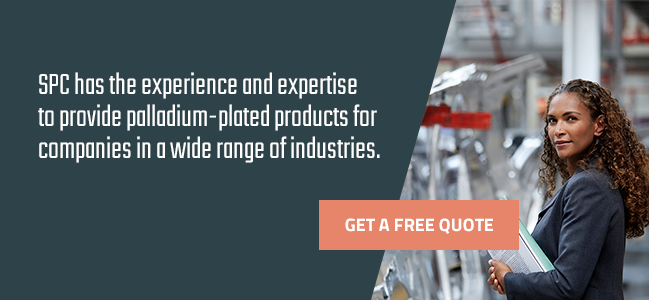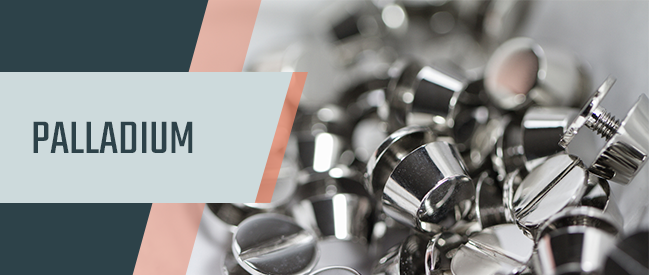
Palladium is a precious metal with numerous properties that make it an excellent choice of plating material, especially in the automotive and electronics industries. SPC has developed a palladium plating process that reliably provides a high-quality coating for various components and products. Keep reading to learn more about palladium plating, including its characteristics, benefits, drawbacks and applications.
Quick Links
Palladium Plating Methods | Palladium Plating Specifications | Palladium Plating FAQs
Palladium Plating Methods
- Barrel plating
- Rack electroplating
Request a free quote
For Palladium Coating
Palladium Plating Specifications
In some cases, you may need to perform palladium plating according to industry specifications.
ASTM B679 - 98 (2015)
ASTM B679 - 98 (2015) is the standard you are most likely to encounter. The specification, published by ASTM International, lays out requirements for electrodepositing palladium coatings for engineering applications, as well as palladium coatings with thin gold overplates for use in electrical contact applications. It requires indicating the base metal used, the thickness of the palladium coating, the thickness of any underplates and the grade of any gold overplates. It also establishes requirements for sampling and testing coatings and defines standards of purity, adhesion, appearance, ductility, thickness and integrity.
MIL-P-45209B
MIL-P-45209B, the military standard for electrodeposited palladium plating, was once also common. However, the U.S. Department of Defense has canceled the standard and now refers manufacturers to ASTM B679 - 98. The ASTM standard contains some unique requirements for plated components for which the U.S. government or an agent of the government is the purchaser.
Palladium Plating FAQs
Below, you'll find the answers to some of the most common palladium plating questions.
What Is Palladium?
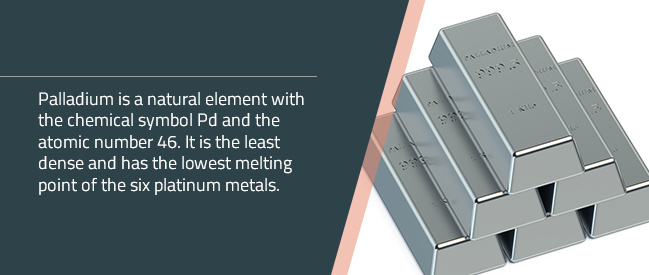
Palladium is a natural element with the chemical symbol Pd and the atomic number 46. It is the least dense and has the lowest melting point of the six platinum metals. It is also a precious metal and shares many characteristics with the other metals in that group. It is a soft metal known for its semi-bright, silvery-blue appearance, as well as its low density and melting point. It makes an excellent catalyst and component of alloys.
What Are the Characteristics of Palladium?
As mentioned in the above section, palladium is easy to recognize due to its somewhat bright, silver-blue appearance, its low density and its low melting point. It has a density of 12 grams per cubic centimeters, a melting point of 2,830.6 degrees Fahrenheit and a boiling point of 5,365 degrees Fahrenheit. Platinum is soft and malleable when annealed, and cold-working can increase its strength and hardness. Perhaps palladium's most unique property is its ability to absorb hydrogen in amounts of up to 900 times its volume. Hydrogen diffuses through heated palladium, which purifies and separates the gas.
What Is the History of Palladium?
As early as the beginning of the 18th century, miners in Brazil had discovered a metal they referred to as ouro podre, meaning "worthless gold." Ouro podre was, as we now know, an alloy of gold and palladium. This alloy was not the material from which people first extracted palladium, however.
William Wollaston of the United Kingdom gets credit for the discovery of palladium. In 1803, he discovered the element by absorbing platinum in aqua regia, which consists of nitric acid and hydrochloric acid. When he did so, some material did not go into the solution and remained as a residue. Wollaston extracted palladium from this residue. He did not immediately announce his discovery, but instead sold it as "new silver." In 1805, he revealed that he had discovered the metal and described its properties. Palladium takes its name from the asteroid Pallas, which German astronomer Heinrich Olbers identified around the same time.
Where Does Palladium Come From?
Most palladium mines are in Russia and South Africa, and other leading producers include Canada and the United States. Most often, it is a byproduct in refining copper and nickel ores, and is also a component of gold and silver ores.
What Does Palladium Electroplating Involve?
SPC has designed the palladium electroplating process to meet the increasing demand for extreme thickness required in the modern manufacturing environment. SPC adheres to best practices throughout the palladium electroplating process to ensure the highest possible quality.
During the palladium electroplating preparation process, we begin by carefully examining the basis material and thoroughly cleaning it via processes such as preheating, polishing and ultrasonic cleaning. As the plating cycles occur, maintaining the proper strikes of palladium and nickel ensures maximum adhesion.
After the palladium plating process, a heat treatment removes any excess trapped hydrogen from the final product. Additional processes, such as applying a secondary gold plating coating on top of the palladium plating, can also enhance protection.
What’s the Cost of Plating With Palladium?
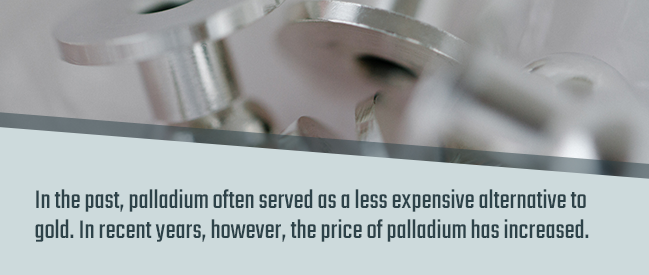
In the past, palladium often served as a less expensive alternative to gold. In recent years, however, the price of palladium has increased as the supply of the material has struggled to keep up with the growing demand. This increase in demand is due largely to its use in catalytic converters in automobiles. Although the cost of using palladium has increased, its many beneficial properties mean it may still be the right choice of material for specific applications. You can also get many of the positive attributes of palladium at a lower cost by alloying it with other metals such as nickel and cobalt.
What Are the Benefits of Electroplating With Palladium?
Why might you choose to use palladium for electroplating? Some of its benefits include the following:
- Resistance to corrosion: Palladium is naturally resistant to many corrosive forces. It has about the same level of corrosion resistance as gold, meaning that the risks of palladium corrosion are low.
- Relative hardness: While palladium is a softer metal, it is significantly harder than gold, silver, platinum and various other metals. This hardness means palladium is more resistant to impacts and wear and tear.
- Ability to function as a catalyst: Palladium's ability to act as a catalyst makes it valuable in various applications. Automotive catalytic converters represent the main use of palladium. In this application, the palladium helps convert carbon monoxide, hydrocarbons and nitrogen oxide in the vehicle's exhaust into more benign water, nitrogen and carbon dioxide emissions.
- Low density: Palladium is light but is still durable, which is especially useful for jewelry.
What Are the Potential Drawbacks of Plating With Palladium?
Palladium has many beneficial properties, but there are some disadvantages to using it that may make other metals a better choice in specific applications. Some of these drawbacks are as follows.
- Limited heat resistance: Palladium has a low melting point and limited heat resistance. When subjected to extreme heat, palladium tends to discolor or even deform. Palladium is often not the best choice for components that will frequently experience high heat.
- Susceptibility to acids: Palladium is resistant to many corrosive forces, but it is vulnerable to damage by strong acids. Because of this weakness, palladium is not ideal for parts that may come into contact with acids.
- Susceptibility to cracking: The hardness of palladium means that it is somewhat prone to cracking when under stress. Only one small crack can affect the integrity of an entire component, so resistance to cracking is crucial in some applications. You can reduce palladium’s susceptibility to cracking by alloying it with other metals.
- Price increases:In the past, the relatively low cost of palladium was a major reason to use it. However, its price has increased in recent years, making it more expensive than gold and other precious metals.
What Are Some Common Applications of Palladium Plating?
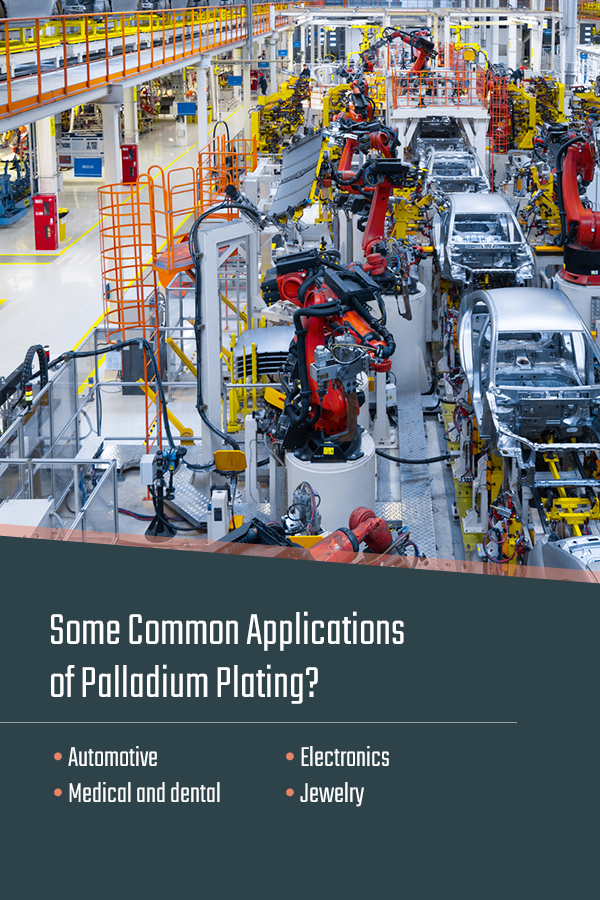
Leading metal finishing companies such as SPC are now using palladium for numerous electroplating applications across a wide range of industries.
- Automotive: As automobile manufacturers strive to comply with increasingly strict emissions requirements, palladium plating has become a popular choice for use in the production of catalytic converters that transform toxic materials in engine exhaust into nontoxic substances that are also safer for the environment. Palladium's excellent ability to absorb hydrogen makes it ideally suited for this application.
- Medical and dental: Palladium's nontoxic properties have made it a preferred choice in the United States in the manufacturing of dental products and appliances such as crowns, inlays and bridges, replacing the gold alloys that were popular for many years. Japanese law now requires all dental alloys to consist of a palladium content of at least 20%.
- Electronics: Capacitors, which control the electric current that flows through devices such as cell phones and laptop computers, frequently have palladium plating. Palladium plating is also widespread in the manufacturing of connectors and semiconductors. This process typically involves building the thickness of the deposit with palladium and then flashing with a layer of gold.
- Jewelry: Palladium's unmistakable aesthetic appeal makes it a desirable plating option in the manufacturing of fine jewelry or any product where a lustrous, silver-white color is preferable to a yellow-gold finish.
What Are the Alternatives to Plating With Palladium?
When choosing metals to use for plating, two of the most common alternatives to palladium are gold and rhodium. Here's how palladium compares with these two metals.
Gold
Palladium and gold share many properties, but there are also some differences between them. Here's how they compare:
- Due to recent price changes, gold is now less expensive than palladium.
- Gold and palladium offer a similar level of corrosion resistance.
- Gold is softer and less durable than palladium. Gold has a Knoop hardness of 200, while palladium has a Knoop hardness of 400.
- Copper will diffuse through a gold coating, eliminating its useful properties, but will not diffuse through a palladium finish.
- Gold has a higher melting point than palladium.
- Gold has heat transfer capabilities that palladium lacks.
- Because gold is softer, it is less prone than palladium to cracking when placed under stress.
- Both gold and palladium can serve as a catalyst, including in catalytic converters, although palladium is much more common for this purpose.
Rhodium
Another alternative to palladium is rhodium. Here's how these two metals compare:
- Rhodium has a lower electrical resistance than palladium.
- Rhodium is harder than palladium.
- Rhodium is slightly denser than palladium.
- Rhodium has a higher melting point than palladium.
- Both rhodium and palladium make excellent as catalysts, including in catalytic converters.
- Rhodium is more expensive than palladium.
What Metals Can Alloy With Palladium?
It's common to see palladium alloyed with other metals such as nickel and cobalt. Manufacturers may use these alloys, rather than pure palladium, for plating because of their lower costs, as well as the enhanced properties they provide. Here's a look at palladium-nickel and palladium-cobalt alloys.
- Nickel: Palladium-nickel alloys typically consist of 20 to 30% nickel and 70 to 80% palladium. They are more resistant to stress and cracking than pure palladium, making them useful for applications in which durability is essential. They also offer improved resistance to heat and galvanic corrosion, reduced porosity and excellent solderability.
- Cobalt: It's possible to deposit palladium-cobalt alloys in greater thicknesses than pure palladium, and using them can decrease your costs as compared to using pure palladium. The connector industry frequently uses palladium-cobalt alloys, and you can often find them in cell phones, computer batteries and semiconductor packages.
What Are Some Everyday Palladium Electroplating Issues?
To ensure a successful plating process, you need to have a precise plating process and watch out for common palladium electroplating issues.
- Stress cracks: One of the most frequent problems that occurs with palladium electroplating is stress cracking. The incorporation of hydrogen into the palladium during the plating processes can lead to these cracks. To prevent this issue, minimize the hydrogen-to-palladium deposition ratio by carefully controlling the plating baths and conditions.
- Adhesion problems: You may also encounter issues related to adhesion. This problem may occur due to the presence of debris on the surface of the substrate. It is essential to use pretreatments to clean the substrate before beginning the plating process.
- Dull plating deposits: Palladium plating should be somewhat shiny, but if problems occur during the plating process, you may end up with a cloudy or hazy coating. Various issues, including improper temperature, improper chemical mixture and incorrect current distribution, can lead to a dull deposit. Carefully controlling the plating process can help prevent this.
Other issues to look out for include blistering in the plating, sharp edges, cleavage points, cold shuts and pitting.
The SPC Advantage in Palladium Electroplating
SPC has the experience and expertise to provide palladium-plated products for companies in a wide range of industries. SPC has developed our palladium plating process through extensive laboratory testing, including design of experimental procedures. The result is a highly reliable process that results in a finished palladium plating product free of cracks and stresses, while providing greater density and porosity. The palladium plating process has also received validation from a variety of leading OEMs across the electronics and catalyst industries.
SPC takes a “quality-first” approach to providing the most effective and reliable palladium plating solutions to our valued clients. Our broad palladium plating capabilities come from a combination of vast industry experience and modern innovation. With a cutting-edge, 70,000-square-foot South Central Pennsylvania facility and a dedicated team of scientists, engineers and production experts, we can meet any palladium plating needs.
To learn more about how the SPC palladium electroplating process can benefit your business or to receive a no-obligation quote for our services, contact us today.
Additional Resources:
CONTACT US TO LEARN MORE ABOUT OUR PALLADIUM PLATING SERVICES
To learn more about how the SPC palladium electroplating process can benefit your business or to receive a no-obligation quote for our services, contact us today.
LEARN WHAT OUR MANY SATISFIED CUSTOMERS HAVE TO SAY ABOUT Us
"I would like to thank you for the help you have provided us in developing an electroless nickel plating technique on an unusual substrate. The sample platings you provided show that we should be able to reach our goals. I especially appreciate your willingness to take on an unusual job, with the uncertainties that that entails...We are looking forward to working with you in the future on our plating needs."
– Robert K.


